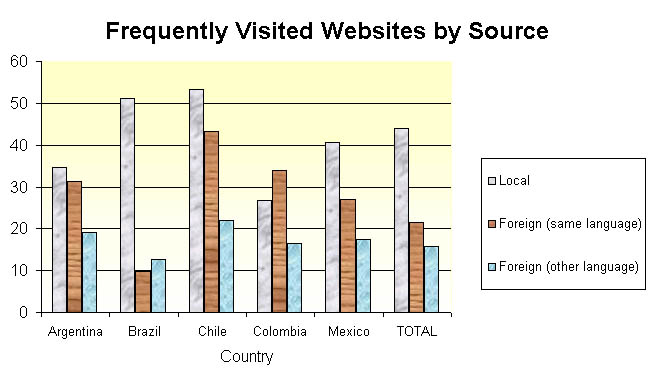
Preference for Foreign vs. Local Websites
The World Wide Web makes available a very large number of websites to users. Everyday, more and more websites are being created from all over the world in different languages. This becomes a typical competitive market situation --- a very large number of surfers ("buyers") are presented with a very large number of websites ("sellers") --- and the laws of supply and demand take over. In this particular situation, due to the existence of many sellers of differentiated products, the buyer is blessed with many choices.
So how does the consumer choose? In a previous note (A Latin American Demographic Map of Internet Activities ), we had shown how personal needs, tastes and lifestyle characteristics affect choice. Of course, there are many other reasons to make one's choices. In this note, we will focus on the origin of the websites.
For classification purposes, we divide websites into (1) those that are from one's own country; (2) those that from a foreign country but in one's own language; and (3) those that from a foreign country and not in one's own language. In practice, the dividing lines are not always clear cut. For example, consumers may differ in their perceptions as to whether or not a pan-regional portal such as Starmedia.com is a local or foreign entity.
We will now cite some data from the TGI.net study. This is a survey of Internet users in Argentina, Brazil, Chile, Colombia and Mexico. For the 6,669 persons between the ages of 12 to 64 years old who used the Internet in the past 90 days, the frequencies of usage of websites from different origins are shown in the following chart. The trend is distinct in that local websites are preferred over foreign websites in one's own language, which is in turn preferred over foreign websites in other languages.

But before we assert the universal triumph of the local over the global, we should look at some finer details. In the next chart, we show the percent of people who indicate that they frequently visited websites of different origin, now broken out separately by country. Now, we see some significant differences.

The first observation derives from the fact that Latin America is composed of Portuguese-speaking Brazil, which account for about 40% of the population, and other Spanish-speaking countries. In the case of Brazil, the only other major country with the same language is Portugal, which has a smaller population. This means that the number of 'foreign websites with one's own language' is in fact fairly small for Brazilians. This is compounded by the fact that the relatively large number of Internet users in Brazil has propelled the emergence of a large number of excellent local websites.
The second observation derives from the general development of internet websites in the Spanish-speaking countries. At this stage, Argentina, Chile and Mexico have relatively well-developed collections of local websites, in the sense that some of these local websites have the coverage, depth and sophistication of the pan-regional powerhouses. The weakest point in the set of countries here is Colombia, in the sense of having relatively fewer users and relatively fewer first-rate websites, and this explains why Colombians are more apt to use Spanish-language websites from elsewhere.
(posted by Roland Soong, 4/4/2001)
(Return to Zona Latina's Home Page)